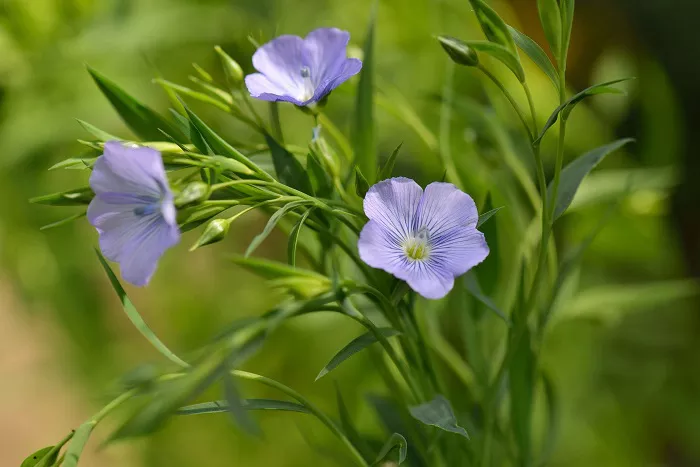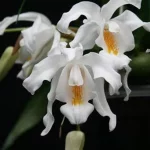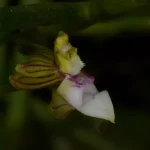Flax is a versatile and ancient plant known for its historical and cultural significance. From being an essential crop for textiles to its symbolic meanings in art, religion, and even tattoos, the flax flower carries rich layers of interpretation. In this article, we will explore the symbolism and meaning behind the flax flower, including its significance in love, death, spirituality, and how it is represented in various colors. Let’s dive deeper into the multiple layers of meaning of this fascinating flower and its place in human culture.
Flax Flower Symbolism
What Does the Flax Flower Represent?
The flax flower (Linum usitatissimum) is an iconic plant that has been cultivated for thousands of years, both for its practical uses and for its symbolic meanings. Historically, flax has been a valuable resource for making linen fabric, and it was once considered sacred in many ancient cultures. It represents purity, simplicity, and new beginnings due to its delicate appearance and graceful petals.
In some cultures, flax is associated with transformation, especially in the process of turning raw flax fibers into cloth. This idea of transformation translates into the symbolic meaning of personal growth, renewal, and spiritual metamorphosis.
In ancient Egypt, flax was revered for its use in making garments for the pharaohs and priests, symbolizing purity, divine protection, and the cyclical nature of life and death. In Greek and Roman cultures, flax was connected to the goddess Venus (Aphrodite in Greek mythology), who represented love, beauty, and fertility.
The flax flower’s symbolism often extends beyond mere aesthetics, touching on themes of resilience, sustainability, and rebirth.
Flax Flower Meaning in Different Colors
The Meaning of Blue Flax Flowers
The most common color associated with the flax flower is blue, which is often seen in fields of flax during bloom. Blue flax flowers are widely admired for their vivid color and graceful presence. The blue flax flower is particularly associated with peace, tranquility, and harmony. It can be seen as a symbol of calm and serenity, evoking the vastness of the sky or the depth of the ocean.
In many cultures, blue is also a color that represents fidelity, truth, and trust. The blue flax flower, therefore, can symbolize loyalty in relationships and spiritual truths. It is a color that carries the energy of communication, both in terms of clear expression and emotional connection.
The Meaning of White Flax Flowers
While blue is the most common color, flax flowers can sometimes appear white, particularly in cultivated varieties. White flax flowers symbolize purity, innocence, and spiritual clarity. In Christian symbolism, white flowers are often associated with the Virgin Mary and the purity of the soul. White flax flowers could be seen as a representation of the soul’s purity and the divine light that guides human existence.
For some, white flax may also carry a meaning of simplicity and renewal. The unassuming nature of the white flax flower could symbolize new beginnings and the hope for a fresh start in life, much like the blank canvas that signifies potential.
The Meaning of Pink and Other Colored Flax Flowers
Although rarer, pink or even purple flax flowers are sometimes seen. These colors carry the meaning of love, compassion, and emotional connection. Pink in particular is associated with tenderness, affection, and unconditional love. A pink flax flower could symbolize romantic love or deep emotional bonds, and may be seen as a gift to express love, care, and respect.
Purple flax flowers, with their deeper hue, symbolize spiritual awareness, nobility, and dignity. Purple is often a color linked to higher consciousness and enlightenment, so purple flax flowers might symbolize a person’s journey toward spiritual or intellectual awakening.
See Also: Firewheel Spiritual Meaning and Symbolism
Flax Flower Meaning in the Bible
Flax in Biblical Context
In biblical times, flax was a commonly used material for weaving fabrics, and its significance can be found in both the Old and New Testaments. The plant itself is mentioned in various books, most notably in the Book of Exodus, where it is listed among the materials used to construct the Tabernacle. This connection to sacred spaces imbues flax with spiritual significance.
The Bible often uses plants and flowers to symbolize moral qualities or divine truths, and flax is no exception. In the Book of Isaiah, flax is used metaphorically to signify righteousness and purity. For example, Isaiah 19:9 speaks of the loss of the flax industry in Egypt, which was a disaster for the nation, symbolizing the breakdown of spiritual and moral order.
Flax was also used to make linen cloth for the vestments of priests and religious leaders, further establishing its connection to holiness, sacred duties, and purity. This connection makes flax flowers an appropriate symbol for divine intervention, spiritual awakening, and redemption in the Christian tradition.
Flax in Biblical Imagery
The Bible uses flax in various poetic and metaphoric ways. In particular, flax is associated with virtues like righteousness, virtue, and truth. In some interpretations, the flax flower can symbolize divine beauty, offering a reminder of the sanctity of life and the importance of living in accordance with divine teachings.
While the flax flower itself is not explicitly mentioned as a symbol in many biblical passages, the use of flax to make linens has strong spiritual connotations related to purity, righteousness, and holiness.
Flax Flower Meaning in Tattoos
Flax Flowers in Tattoo Culture
Flax flowers are sometimes chosen for tattoos because of their delicate beauty and symbolic meanings. Tattoos of flax flowers are often chosen by individuals who seek to express qualities such as purity, renewal, or transformation. The flower’s graceful petals make it a popular choice for those looking to represent femininity, subtlety, and strength.
Tattoos of blue flax flowers can signify peace and emotional balance, while pink flax tattoos may represent love, compassion, and romantic attachment. A tattoo of a flax flower can also serve as a reminder of the importance of personal growth and transformation.
Flax Flower Tattoo Placement
Because of the flax flower’s elegant form, it’s a popular choice for more feminine or soft designs, and it is often placed in areas such as the wrist, ankle, or back of the neck. The tattoo may be a small, simple design or larger, more detailed artwork depending on personal preference.
People who choose flax flower tattoos often view them as a symbol of hope or new beginnings. Whether it’s a tribute to overcoming a personal challenge or a way to commemorate a fresh start in life, the flax flower in tattoo art has deep emotional significance for many wearers.
Flax Flower Meaning in Love
Flax Flowers as Symbols of Love and Romance
Flax flowers, particularly in their blue or pink forms, are often seen as symbols of love. Their delicate beauty and gentle appearance are perfect representations of romantic love, affection, and loyalty. The flax flower’s symbolism in love is multifaceted—while it can signify tender affection, it can also represent deeper emotional bonds, trust, and fidelity in a relationship.
In some interpretations, the flax flower’s ability to be woven into linen is metaphorically connected to the way love binds people together. Just as flax fibers are spun and twisted together to form strong threads, so too can love weave two hearts into a lasting bond.
Flax Flowers in Romantic Gestures
Flax flowers can be incorporated into romantic gestures, whether in floral bouquets, artwork, or even as part of a wedding ceremony. A bouquet featuring blue flax flowers may symbolize a calm and steady love, while pink flax flowers can express affectionate love or even the blossoming of new relationships.
In some cases, the blue flax flower can also represent a love that is grounded in truth and open communication. It’s a flower that encourages clarity and trust between partners, which are essential qualities for a long-lasting, healthy relationship.
Flax Flower Meaning in Death
Flax Flower Symbolism in Death and Mourning
Flax flowers, especially in their white and blue forms, may also be associated with death and mourning. White flowers in general are commonly linked to funerals and remembrance, symbolizing purity and the transcendence of the soul. In this context, the flax flower represents the passage of the soul from the earthly realm to the divine or eternal.
Flax flowers can also signify rebirth and renewal, offering a sense of peace to those grieving. Just as flax is transformed into linen, the process of death is seen as a form of transformation—a transition from one state of being to another.
Flax Flowers at Funerals and Memorials
While not as common as other flowers used in funerals, flax flowers may appear in memorial arrangements for individuals who valued simplicity, peace, or spiritual growth. They symbolize the continuity of life and the enduring connection between the living and the deceased, much like how flax seeds, once planted, yield new life.
Flax Flowers as a Symbol of the Afterlife
In some traditions, the flax flower represents the eternal nature of the soul. The delicate petals may symbolize the fragility of life, while the roots of the flax plant suggest an enduring connection to the earth and to those who have passed on. This interpretation can bring comfort to those who are grieving, offering the notion that loved ones live on in spirit, even as their physical presence fades.
Conclusion
The flax flower is far more than a simple botanical specimen—it is a symbol of deep cultural, spiritual, and emotional meaning. From its significance in the Bible to its use in tattoos, the flax flower carries with it a message of purity, renewal, and transformation. Whether it represents love, death, or the transition from one state of being to another, the flax flower speaks to the human experience in ways both subtle and profound. Its gentle beauty continues to captivate people across cultures and generations, and it remains a powerful symbol of the cycles of life, love, and rebirth.
Related topics:













